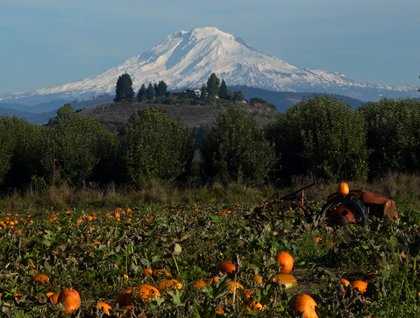Early this morning National Geographic Sea Bird departed from the dock in The Dalles and continued downriver to the town of Hood River, Oregon. This is the gateway to the orchards and vineyards of the Hood River Valley. It was a calm and clear, sunny day, and we had spectacular views of two prominent Cascade volcanoes—Mount Hood (11,235’, Oregon) and Mount Adams (12,307‘, Washington), both noted by Lewis and Clark—as we took the short ride up the valley to visit Rasmussen’s Farm. Here we were able to sample local produce and preserves and had time for photographic expression.
Returning to town, some people opted to explore Hood River, including a visit to a yarn store.
As we departed Hood River, several sailboats were also preparing to leave the marina. The Columbia River Gorge is known for strong wind and this area is a Mecca for wind- and kite-surfers and other sailors. This afternoon the wind had only picked up slightly and it was still a very pleasant day to be on the water.
A short distance downstream, our vessel docked at Cascade Locks, Oregon, where sternwheelers once bypassed rapids in this area. We disembarked and rode downstream to visit Multnomah Falls—a beautiful skein of water that falls about 620 feet in two levels. Our professional photographers provided instruction on capturing interesting images and there was also a chance to stretch our legs and turn a few of the eleven switchbacks that zigzag toward the top of the falls.
Back on board, shipboard historian Don spoke on the life and times of Jean Baptiste Charbonneau—“Pomp,” the son of Sacagawea and the interpreter Toussaint Charbonneau.
We reached Bonneville Dam and margaritas flowed as we entered the chamber to descend about 60 feet in our final lock of the voyage. The first federal dam on the Columbia River, Bonneville was completed 1938.
Below the dam, seasonal colors accentuated the dramatic terrain, and we pointed out landmarks and features observed by Lewis and Clark. As we passed Beacon Rock, we could see the trail that ascends the 840-foot-high volcanic neck. Phoca rock was named for the harbor seals (Phoca vitulina) that alerted the explorers, still over 100 miles from the ocean, to their imminent approach to the sea. From the river, we had a different perspective of Multnomah Falls. We enjoyed the sunshine all afternoon.
Our evening Recap included Jim’s preview of the video chronicle before dinner. Don completed the day with his discourse on the trials and tribulations of the Corps of Discovery as they reached the mouth of the Columbia River in November of 1805.







